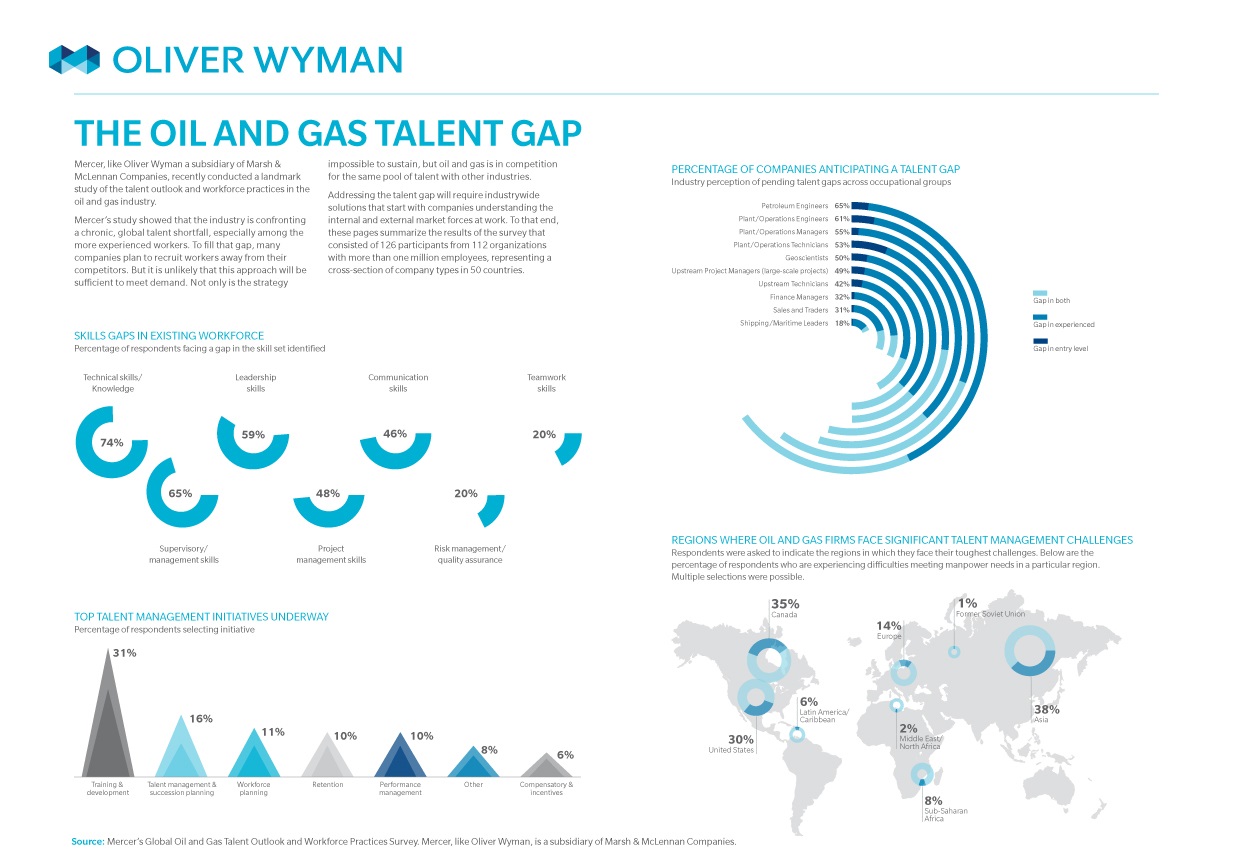 Oil and gas executives won’t be prepared to meet tomorrow’s production demand if they don’t quickly address the one asset about which they know the least: their people.
Oil and gas executives won’t be prepared to meet tomorrow’s production demand if they don’t quickly address the one asset about which they know the least: their people.
Today’s most commonly used solution to fix workforce shortages is to hire top talent away from competitors. But this approach amounts to little more than an industrywide addiction to reshuffling the same thinning deck of cards.
A recent oil and gas talent outlook survey of more than 100 oil and gas managers in 50 countries conducted by Oliver Wyman’s sister company Mercer revealed that most energy industry managers anticipate a significant, and growing, talent gap in the next five years. Many believe their companies could yield meaningful returns if they can solve their talent challenges — in the form of greater productivity, lower rates of attrition, increased production and decreased operating costs.
Unfortunately, these goals are not achievable on a sustainable basis if every company resorts to poaching in order to replace their retiring baby boomer workforce, driving up labor costs for the entire industry. Raiding is an increasingly difficult and expensive option – in large part because rapidly expanding national oil companies, refiners, international oil companies and new entrants are all competing for employees with similar skills in what is now a fluid international market. And yet, a majority of the respondents who employ more than one million workers in the aggregate say they hire workers from outside the organization versus promoting, training and transferring existing employees.
So what can be done?
CAST A WIDER NET
For starters, human resources executives should expand their scope and cast a wider net. When considering the core qualities and traits needed to fill many of the vacancies, executives will find that workers in other adjacent professions may be excellent candidates. For example, certain oil and gas roles would be ideal for employees who once were firefighters, police officers or automotive technicians; served in the military; or worked in prison support roles and manufacturing. Certain civil, chemical and electrical engineering professions also have viable transferrable skills.
Social technologies can assist oil and gas companies with tapping into a larger pool of candidates. With the aid of cutting edge social data technology, oil and gas firms can sift through tens of thousands of candidates to find an ideal group of 300 to 350 candidates with the right motivational and behavioral characteristics and appropriate work history to fit their cultures relatively easily. They can also take their typical employee referral programs to a higher level by asking top employees for permission to access their Facebook or LinkedIn profiles to uncover great leads and excellent coworkers.
At the same time, some companies should consider implementing apprentice programs. While these types of initiatives might not be a short-term solution to their problems, companies might be able to partially bridge their gaps by offering alternative paths to college. In addition, they should ramp up recruiting efforts aimed at rekindling interest and excitement in the energy industry at target universities.
CODIFY UNWRITTEN KNOWLEDGE
Companies would also be wise to take the time to capture the unwritten knowledge of employees readying for retirement and offer flexible workweeks and phased retirement programs. Our survey shows that within the next five years, oil and gas companies could lose 50 to 80 percent of workers age 55 and older, which equates to 150,000 years of experience.
This is not a simple task. These soon-to-be retirees’ unwritten knowledge from years of experience needs to be captured and codified, either on the job or in a classroom, and transferred to the rest of the organization, so that less experienced workers are prepared to move into the senior ranks. For this to happen, retirees need to be trained and incentivized to be teachers and coaches. This can require helping many to learn how to connect with the younger generation.
DEVELOP A WORKFORCE STRATEGY
Finally, companies should invest in modeling scenarios of what their workforce strategies are going to look like. They need to create better professional development paths to improve the “hit rate” of both producing and retaining great staff. One way to achieve this is for companies to plot optimal paths in their organizations to enhance the development of both technical and managerial staff, potentially shortening the journey to senior positions.
Without this data, energy executives are blindly placing bets in the hope of landing the necessary talent. Perhaps the roulette wheel will land on their numbers. But this is a dangerous gamble, given that the ability of oil and gas companies to secure talent will have as great an impact on the investments they pursue as other key strategic considerations like the quality of potential assets and access to funds. Human resource executives need to step up and provide clarity around both the talent gaps that are developing and the creative workforce-building techniques that can solve them. Only then will future wagers be sound.
by: JOHN KOOB & KERIC MORRIS
-
 Read More
Read MoreInsights Interview with Rui Barbas, Chief Strategy Officer at Nestlé USANavigating the Present and Transforming for the Future
-
 Read More
Read MoreInsights Ferran Reverter Planet is Chief Executive Officer of the MediaMarktSaturn Retail Group, Europe’s leading consumer electronics retailer.Turning A Crisis Into A Catalyst For Change
-
 Read More
Read MoreJournals We interviewed global senior retail executives for the Retail And Consumer Journal, Volume 8, on the pandemic challenges they faced and the new opportunities it provided.Changing Consumers, New Opportunities
-
 Read More
Read MoreInsights Four ways to move beyond fear.How To Make Risk Functions More Courageous



